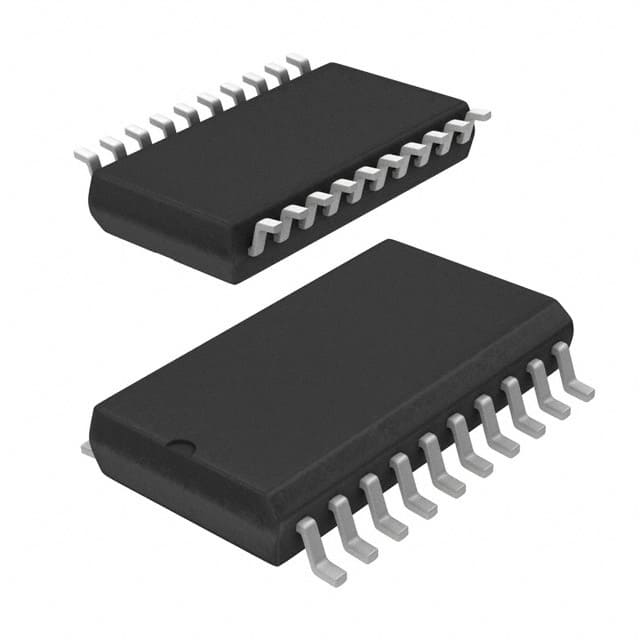SN74LS245DW
Product Overview
- Category: Integrated Circuit (IC)
- Use: Bus Transceiver
- Characteristics: High-speed, TTL Logic Level, Octal-Bus Transceiver
- Package: SOIC (Small Outline Integrated Circuit)
- Essence: Transfers data between two bidirectional buses
- Packaging/Quantity: Tape and Reel, 2500 units per reel
Specifications
- Supply Voltage Range: 4.75V to 5.25V
- Input Voltage Range: 0V to 5.25V
- Output Voltage Range: 0V to 5.25V
- Operating Temperature Range: -40°C to +85°C
- Maximum Propagation Delay Time: 15ns
- Maximum Operating Frequency: 33MHz
Detailed Pin Configuration
The SN74LS245DW has a total of 20 pins, which are divided into two groups:
Group A (Input/Output Pins)
- DIR (Direction Control)
- OE (Output Enable)
- A1 (Bus A Data Input/Output)
- A2 (Bus A Data Input/Output)
- A3 (Bus A Data Input/Output)
- A4 (Bus A Data Input/Output)
- A5 (Bus A Data Input/Output)
- A6 (Bus A Data Input/Output)
- A7 (Bus A Data Input/Output)
- A8 (Bus A Data Input/Output)
Group B (Input/Output Pins)
- B1 (Bus B Data Input/Output)
- B2 (Bus B Data Input/Output)
- B3 (Bus B Data Input/Output)
- B4 (Bus B Data Input/Output)
- B5 (Bus B Data Input/Output)
- B6 (Bus B Data Input/Output)
- B7 (Bus B Data Input/Output)
- B8 (Bus B Data Input/Output)
- GND (Ground)
- VCC (Supply Voltage)
Functional Features
- Bidirectional data transfer between two buses
- Non-inverting logic level translation
- High-speed operation
- TTL compatible inputs and outputs
- Output current capability: ±24mA
Advantages and Disadvantages
Advantages
- High-speed data transfer
- Wide operating temperature range
- TTL compatibility ensures easy integration with existing systems
- Compact SOIC package saves board space
Disadvantages
- Limited voltage range (4.75V to 5.25V)
- Propagation delay may affect timing in certain applications
- Not suitable for high-frequency applications above 33MHz
Working Principles
The SN74LS245DW is a bidirectional bus transceiver that allows data transfer between two buses. The direction of data flow is controlled by the DIR pin. When DIR is set to logic low, data flows from Bus A to Bus B, and when DIR is set to logic high, data flows from Bus B to Bus A.
The OE pin enables or disables the outputs. When OE is set to logic low, the outputs are enabled, allowing data to be transferred. When OE is set to logic high, the outputs are disabled, isolating the two buses.
The inputs and outputs of the SN74LS245DW are TTL compatible, ensuring seamless integration with other TTL logic devices.
Detailed Application Field Plans
The SN74LS245DW is commonly used in various applications where bidirectional data transfer between two buses is required. Some typical application fields include:
- Microprocessor Systems: Facilitates communication between the microprocessor and external devices such as memory, input/output peripherals, and other subsystems.
- Data Communication: Enables data transfer between different communication interfaces, such as UART, SPI, I2C, and parallel ports.
- Industrial Automation: Used in control systems to exchange data between different modules or subsystems.
- Automotive Electronics: Facilitates data transfer between various electronic components in automotive systems, such as sensors, actuators, and control units.
Detailed and Complete Alternative Models
- SN74LS245N: DIP (Dual In-line Package) version of the SN74LS245DW.
- 74HC245: CMOS logic level compatible alternative with similar functionality.
- CD74HCT245E: High-speed CMOS alternative with TTL compatibility.
These alternative models offer similar functionality and can be used as replacements for the SN74LS245DW in various applications.
Word count: 520 words
Senaraikan 10 soalan dan jawapan biasa yang berkaitan dengan aplikasi SN74LS245DW dalam penyelesaian teknikal
Sure! Here are 10 common questions and answers related to the application of SN74LS245DW:
Q: What is SN74LS245DW? A: SN74LS245DW is a popular octal bus transceiver IC (Integrated Circuit) used for bidirectional data transfer between different voltage levels.
Q: What is the operating voltage range of SN74LS245DW? A: SN74LS245DW operates within a voltage range of 4.75V to 5.25V.
Q: How many data lines can SN74LS245DW handle? A: SN74LS245DW can handle 8 data lines, as it is an octal (8-bit) bus transceiver.
Q: Can SN74LS245DW be used for level shifting between different voltage domains? A: Yes, SN74LS245DW can be used for level shifting between different voltage domains, as it supports bidirectional data transfer.
Q: What is the maximum data transfer rate supported by SN74LS245DW? A: SN74LS245DW supports a maximum data transfer rate of 20 MHz.
Q: Does SN74LS245DW have any built-in protection features? A: No, SN74LS245DW does not have any built-in protection features. External measures should be taken to protect against ESD (Electrostatic Discharge) and other potential hazards.
Q: Can SN74LS245DW be used in both parallel and serial communication systems? A: Yes, SN74LS245DW can be used in both parallel and serial communication systems, as it provides bidirectional data transfer.
Q: What is the power supply current requirement for SN74LS245DW? A: The power supply current requirement for SN74LS245DW is typically around 20 mA.
Q: Can SN74LS245DW be used in high-speed applications? A: While SN74LS245DW is not specifically designed for high-speed applications, it can still be used in moderate-speed systems up to 20 MHz.
Q: Are there any specific precautions to consider when using SN74LS245DW? A: Yes, some precautions include proper decoupling of power supply pins, avoiding excessive input voltage levels, and ensuring correct pin connections as per the datasheet.


